Challenges, Issues, and Barriers in Construction Capacity Management
VerifiedAdded on 2020/07/23
|10
|2728
|77
Report
AI Summary
This report delves into the critical aspects of capacity management within the construction industry, particularly focusing on the challenges, issues, and barriers encountered in planning and control. It highlights the significance of effectively managing resources such as workforce, materials, and finances to meet project deadlines and client requirements, especially within the context of the construction sector in Qatar. The report identifies challenges including changes in construction policies, market volatility, and environmental concerns. It further discusses issues like overestimating resource availability, complexities in planning, and client demand fluctuations. The report also covers barriers such as poor productivity, skilled labor shortages, and project performance issues. Finally, it provides recommendations to improve construction resource capacity planning, including calculating capacities, developing skilled inventories, forecasting demand, and fostering transparency. This report aims to provide insights and strategies for efficient capacity management within the construction sector.
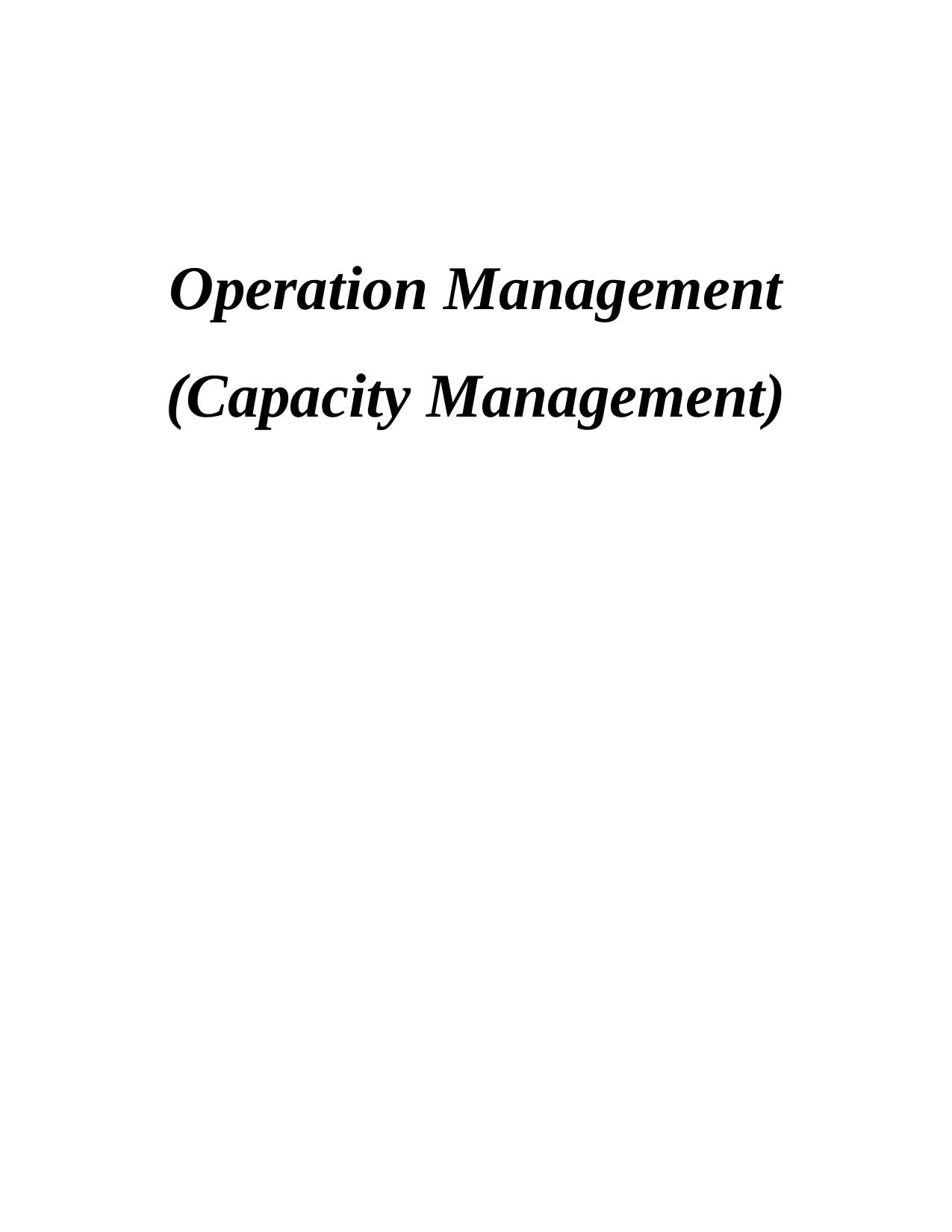
Operation Management
(Capacity Management)
(Capacity Management)
Paraphrase This Document
Need a fresh take? Get an instant paraphrase of this document with our AI Paraphraser
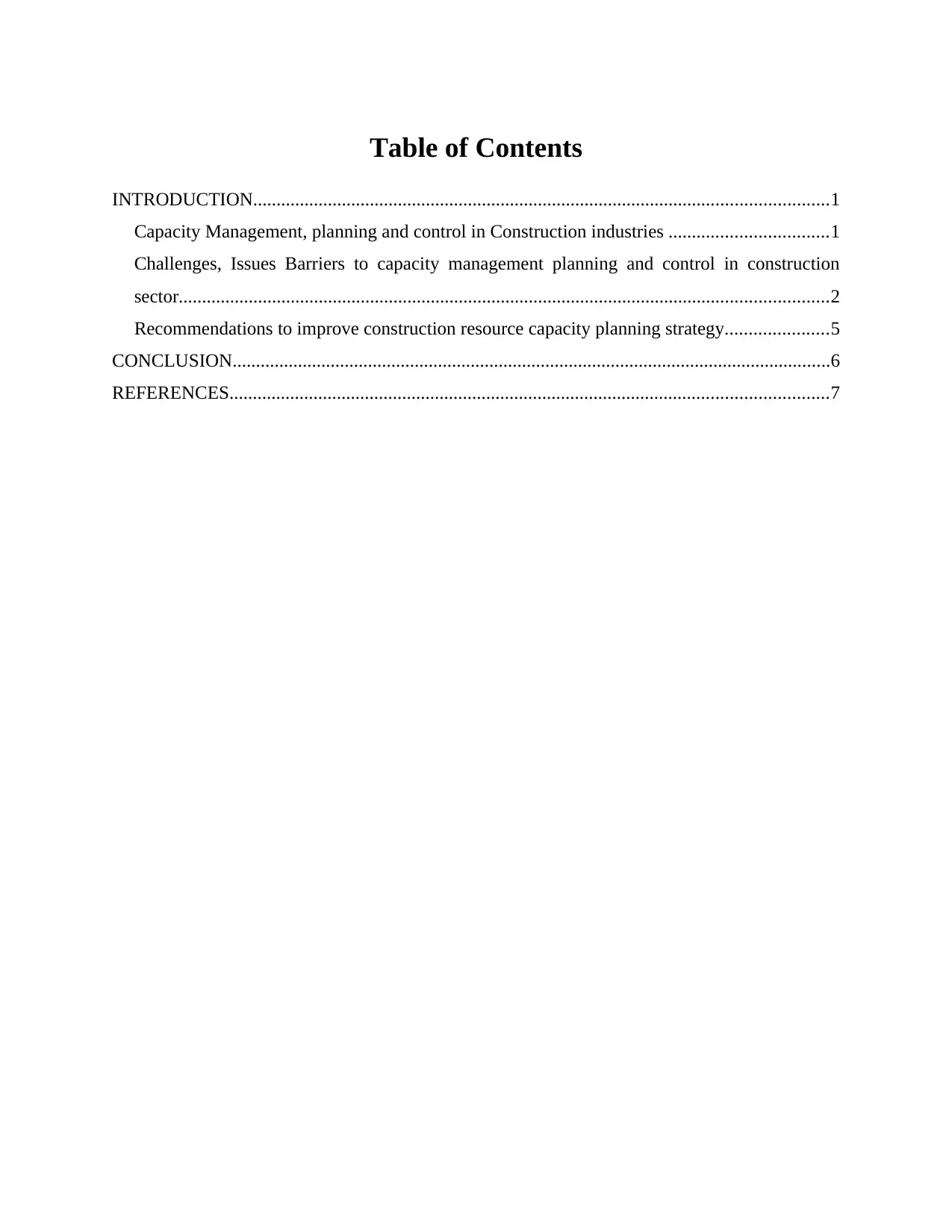
Table of Contents
INTRODUCTION...........................................................................................................................1
Capacity Management, planning and control in Construction industries ..................................1
Challenges, Issues Barriers to capacity management planning and control in construction
sector...........................................................................................................................................2
Recommendations to improve construction resource capacity planning strategy......................5
CONCLUSION................................................................................................................................6
REFERENCES................................................................................................................................7
INTRODUCTION...........................................................................................................................1
Capacity Management, planning and control in Construction industries ..................................1
Challenges, Issues Barriers to capacity management planning and control in construction
sector...........................................................................................................................................2
Recommendations to improve construction resource capacity planning strategy......................5
CONCLUSION................................................................................................................................6
REFERENCES................................................................................................................................7
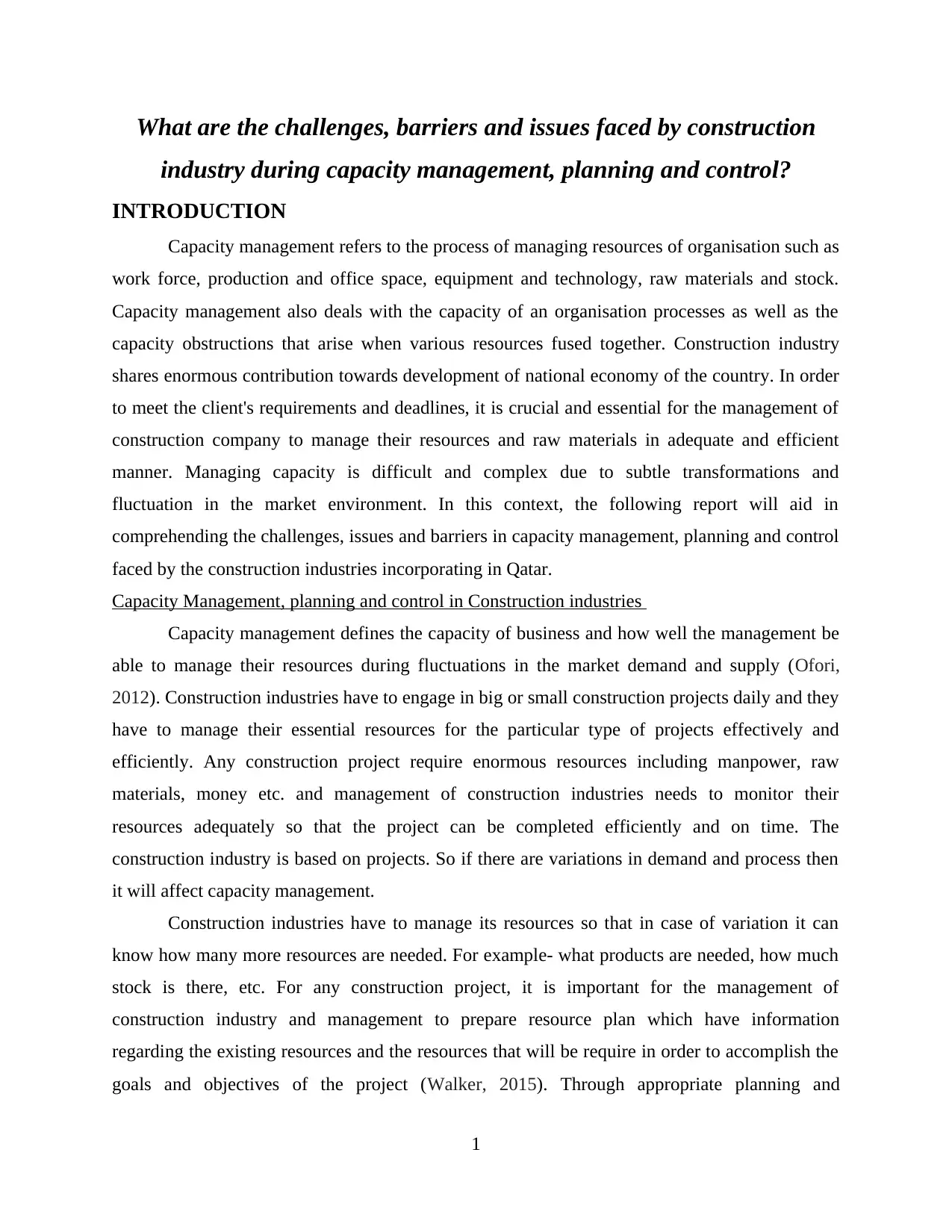
What are the challenges, barriers and issues faced by construction
industry during capacity management, planning and control?
INTRODUCTION
Capacity management refers to the process of managing resources of organisation such as
work force, production and office space, equipment and technology, raw materials and stock.
Capacity management also deals with the capacity of an organisation processes as well as the
capacity obstructions that arise when various resources fused together. Construction industry
shares enormous contribution towards development of national economy of the country. In order
to meet the client's requirements and deadlines, it is crucial and essential for the management of
construction company to manage their resources and raw materials in adequate and efficient
manner. Managing capacity is difficult and complex due to subtle transformations and
fluctuation in the market environment. In this context, the following report will aid in
comprehending the challenges, issues and barriers in capacity management, planning and control
faced by the construction industries incorporating in Qatar.
Capacity Management, planning and control in Construction industries
Capacity management defines the capacity of business and how well the management be
able to manage their resources during fluctuations in the market demand and supply (Ofori,
2012). Construction industries have to engage in big or small construction projects daily and they
have to manage their essential resources for the particular type of projects effectively and
efficiently. Any construction project require enormous resources including manpower, raw
materials, money etc. and management of construction industries needs to monitor their
resources adequately so that the project can be completed efficiently and on time. The
construction industry is based on projects. So if there are variations in demand and process then
it will affect capacity management.
Construction industries have to manage its resources so that in case of variation it can
know how many more resources are needed. For example- what products are needed, how much
stock is there, etc. For any construction project, it is important for the management of
construction industry and management to prepare resource plan which have information
regarding the existing resources and the resources that will be require in order to accomplish the
goals and objectives of the project (Walker, 2015). Through appropriate planning and
1
industry during capacity management, planning and control?
INTRODUCTION
Capacity management refers to the process of managing resources of organisation such as
work force, production and office space, equipment and technology, raw materials and stock.
Capacity management also deals with the capacity of an organisation processes as well as the
capacity obstructions that arise when various resources fused together. Construction industry
shares enormous contribution towards development of national economy of the country. In order
to meet the client's requirements and deadlines, it is crucial and essential for the management of
construction company to manage their resources and raw materials in adequate and efficient
manner. Managing capacity is difficult and complex due to subtle transformations and
fluctuation in the market environment. In this context, the following report will aid in
comprehending the challenges, issues and barriers in capacity management, planning and control
faced by the construction industries incorporating in Qatar.
Capacity Management, planning and control in Construction industries
Capacity management defines the capacity of business and how well the management be
able to manage their resources during fluctuations in the market demand and supply (Ofori,
2012). Construction industries have to engage in big or small construction projects daily and they
have to manage their essential resources for the particular type of projects effectively and
efficiently. Any construction project require enormous resources including manpower, raw
materials, money etc. and management of construction industries needs to monitor their
resources adequately so that the project can be completed efficiently and on time. The
construction industry is based on projects. So if there are variations in demand and process then
it will affect capacity management.
Construction industries have to manage its resources so that in case of variation it can
know how many more resources are needed. For example- what products are needed, how much
stock is there, etc. For any construction project, it is important for the management of
construction industry and management to prepare resource plan which have information
regarding the existing resources and the resources that will be require in order to accomplish the
goals and objectives of the project (Walker, 2015). Through appropriate planning and
1
⊘ This is a preview!⊘
Do you want full access?
Subscribe today to unlock all pages.

Trusted by 1+ million students worldwide
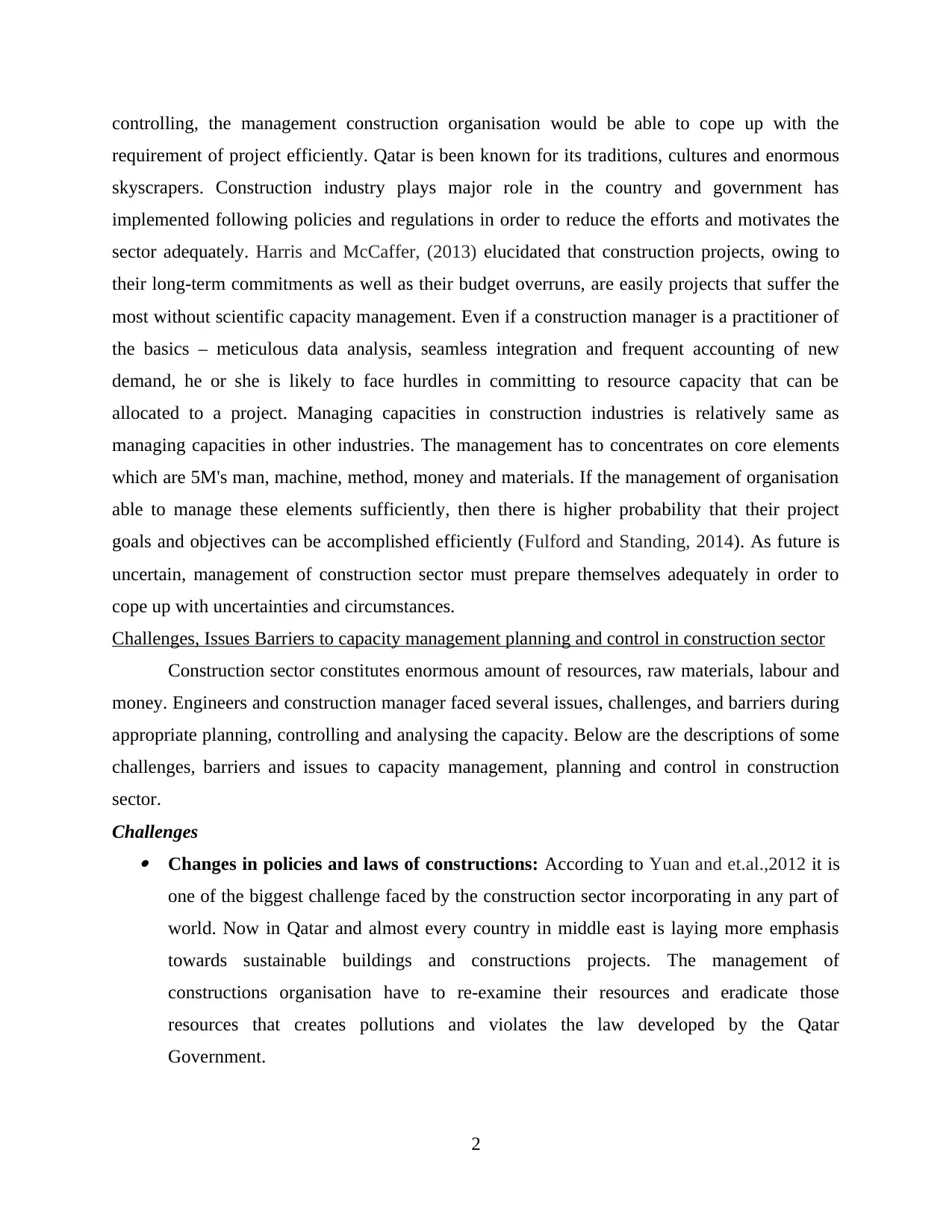
controlling, the management construction organisation would be able to cope up with the
requirement of project efficiently. Qatar is been known for its traditions, cultures and enormous
skyscrapers. Construction industry plays major role in the country and government has
implemented following policies and regulations in order to reduce the efforts and motivates the
sector adequately. Harris and McCaffer, (2013) elucidated that construction projects, owing to
their long-term commitments as well as their budget overruns, are easily projects that suffer the
most without scientific capacity management. Even if a construction manager is a practitioner of
the basics – meticulous data analysis, seamless integration and frequent accounting of new
demand, he or she is likely to face hurdles in committing to resource capacity that can be
allocated to a project. Managing capacities in construction industries is relatively same as
managing capacities in other industries. The management has to concentrates on core elements
which are 5M's man, machine, method, money and materials. If the management of organisation
able to manage these elements sufficiently, then there is higher probability that their project
goals and objectives can be accomplished efficiently (Fulford and Standing, 2014). As future is
uncertain, management of construction sector must prepare themselves adequately in order to
cope up with uncertainties and circumstances.
Challenges, Issues Barriers to capacity management planning and control in construction sector
Construction sector constitutes enormous amount of resources, raw materials, labour and
money. Engineers and construction manager faced several issues, challenges, and barriers during
appropriate planning, controlling and analysing the capacity. Below are the descriptions of some
challenges, barriers and issues to capacity management, planning and control in construction
sector.
Challenges Changes in policies and laws of constructions: According to Yuan and et.al.,2012 it is
one of the biggest challenge faced by the construction sector incorporating in any part of
world. Now in Qatar and almost every country in middle east is laying more emphasis
towards sustainable buildings and constructions projects. The management of
constructions organisation have to re-examine their resources and eradicate those
resources that creates pollutions and violates the law developed by the Qatar
Government.
2
requirement of project efficiently. Qatar is been known for its traditions, cultures and enormous
skyscrapers. Construction industry plays major role in the country and government has
implemented following policies and regulations in order to reduce the efforts and motivates the
sector adequately. Harris and McCaffer, (2013) elucidated that construction projects, owing to
their long-term commitments as well as their budget overruns, are easily projects that suffer the
most without scientific capacity management. Even if a construction manager is a practitioner of
the basics – meticulous data analysis, seamless integration and frequent accounting of new
demand, he or she is likely to face hurdles in committing to resource capacity that can be
allocated to a project. Managing capacities in construction industries is relatively same as
managing capacities in other industries. The management has to concentrates on core elements
which are 5M's man, machine, method, money and materials. If the management of organisation
able to manage these elements sufficiently, then there is higher probability that their project
goals and objectives can be accomplished efficiently (Fulford and Standing, 2014). As future is
uncertain, management of construction sector must prepare themselves adequately in order to
cope up with uncertainties and circumstances.
Challenges, Issues Barriers to capacity management planning and control in construction sector
Construction sector constitutes enormous amount of resources, raw materials, labour and
money. Engineers and construction manager faced several issues, challenges, and barriers during
appropriate planning, controlling and analysing the capacity. Below are the descriptions of some
challenges, barriers and issues to capacity management, planning and control in construction
sector.
Challenges Changes in policies and laws of constructions: According to Yuan and et.al.,2012 it is
one of the biggest challenge faced by the construction sector incorporating in any part of
world. Now in Qatar and almost every country in middle east is laying more emphasis
towards sustainable buildings and constructions projects. The management of
constructions organisation have to re-examine their resources and eradicate those
resources that creates pollutions and violates the law developed by the Qatar
Government.
2
Paraphrase This Document
Need a fresh take? Get an instant paraphrase of this document with our AI Paraphraser
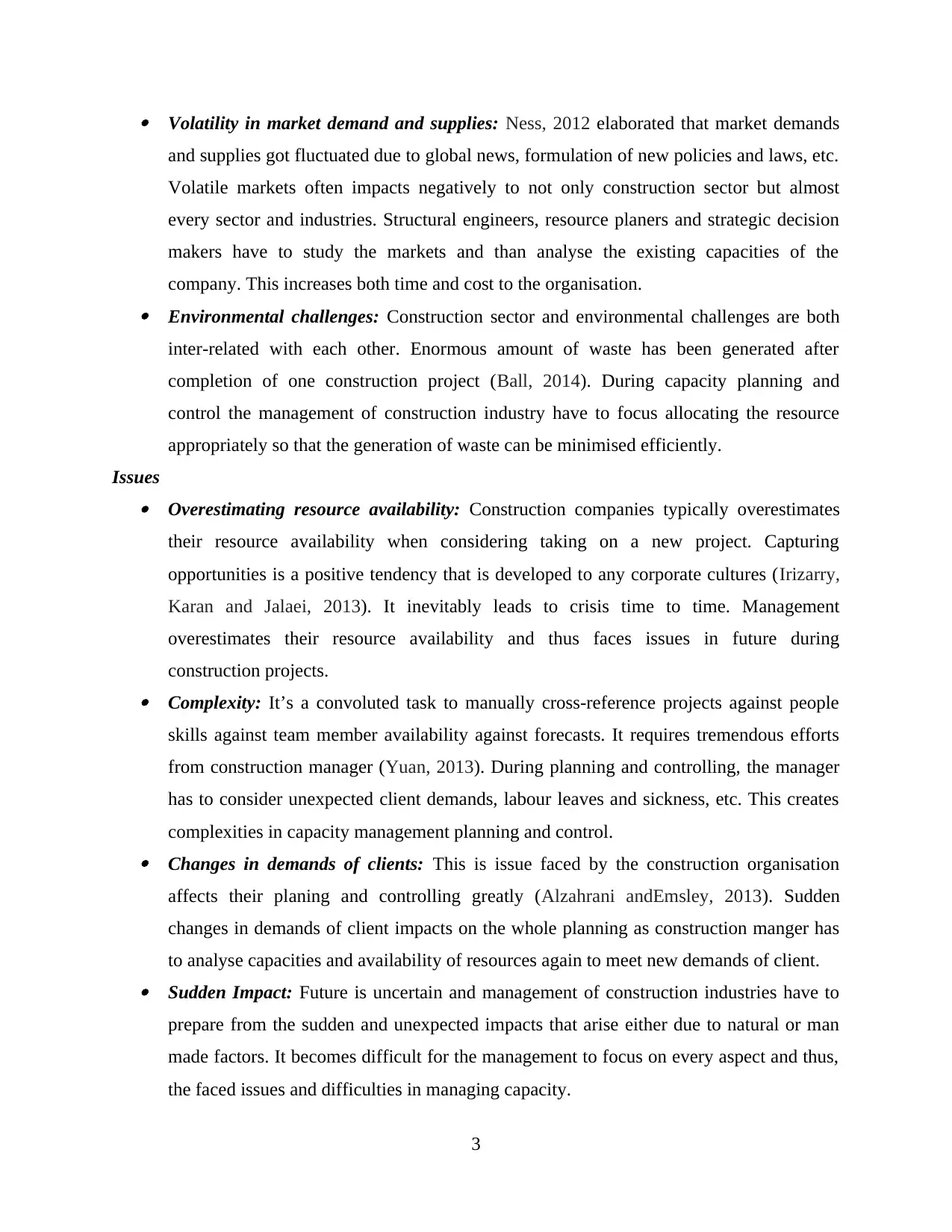
Volatility in market demand and supplies: Ness, 2012 elaborated that market demands
and supplies got fluctuated due to global news, formulation of new policies and laws, etc.
Volatile markets often impacts negatively to not only construction sector but almost
every sector and industries. Structural engineers, resource planers and strategic decision
makers have to study the markets and than analyse the existing capacities of the
company. This increases both time and cost to the organisation. Environmental challenges: Construction sector and environmental challenges are both
inter-related with each other. Enormous amount of waste has been generated after
completion of one construction project (Ball, 2014). During capacity planning and
control the management of construction industry have to focus allocating the resource
appropriately so that the generation of waste can be minimised efficiently.
Issues Overestimating resource availability: Construction companies typically overestimates
their resource availability when considering taking on a new project. Capturing
opportunities is a positive tendency that is developed to any corporate cultures (Irizarry,
Karan and Jalaei, 2013). It inevitably leads to crisis time to time. Management
overestimates their resource availability and thus faces issues in future during
construction projects. Complexity: It’s a convoluted task to manually cross-reference projects against people
skills against team member availability against forecasts. It requires tremendous efforts
from construction manager (Yuan, 2013). During planning and controlling, the manager
has to consider unexpected client demands, labour leaves and sickness, etc. This creates
complexities in capacity management planning and control. Changes in demands of clients: This is issue faced by the construction organisation
affects their planing and controlling greatly (Alzahrani andEmsley, 2013). Sudden
changes in demands of client impacts on the whole planning as construction manger has
to analyse capacities and availability of resources again to meet new demands of client. Sudden Impact: Future is uncertain and management of construction industries have to
prepare from the sudden and unexpected impacts that arise either due to natural or man
made factors. It becomes difficult for the management to focus on every aspect and thus,
the faced issues and difficulties in managing capacity.
3
and supplies got fluctuated due to global news, formulation of new policies and laws, etc.
Volatile markets often impacts negatively to not only construction sector but almost
every sector and industries. Structural engineers, resource planers and strategic decision
makers have to study the markets and than analyse the existing capacities of the
company. This increases both time and cost to the organisation. Environmental challenges: Construction sector and environmental challenges are both
inter-related with each other. Enormous amount of waste has been generated after
completion of one construction project (Ball, 2014). During capacity planning and
control the management of construction industry have to focus allocating the resource
appropriately so that the generation of waste can be minimised efficiently.
Issues Overestimating resource availability: Construction companies typically overestimates
their resource availability when considering taking on a new project. Capturing
opportunities is a positive tendency that is developed to any corporate cultures (Irizarry,
Karan and Jalaei, 2013). It inevitably leads to crisis time to time. Management
overestimates their resource availability and thus faces issues in future during
construction projects. Complexity: It’s a convoluted task to manually cross-reference projects against people
skills against team member availability against forecasts. It requires tremendous efforts
from construction manager (Yuan, 2013). During planning and controlling, the manager
has to consider unexpected client demands, labour leaves and sickness, etc. This creates
complexities in capacity management planning and control. Changes in demands of clients: This is issue faced by the construction organisation
affects their planing and controlling greatly (Alzahrani andEmsley, 2013). Sudden
changes in demands of client impacts on the whole planning as construction manger has
to analyse capacities and availability of resources again to meet new demands of client. Sudden Impact: Future is uncertain and management of construction industries have to
prepare from the sudden and unexpected impacts that arise either due to natural or man
made factors. It becomes difficult for the management to focus on every aspect and thus,
the faced issues and difficulties in managing capacity.
3
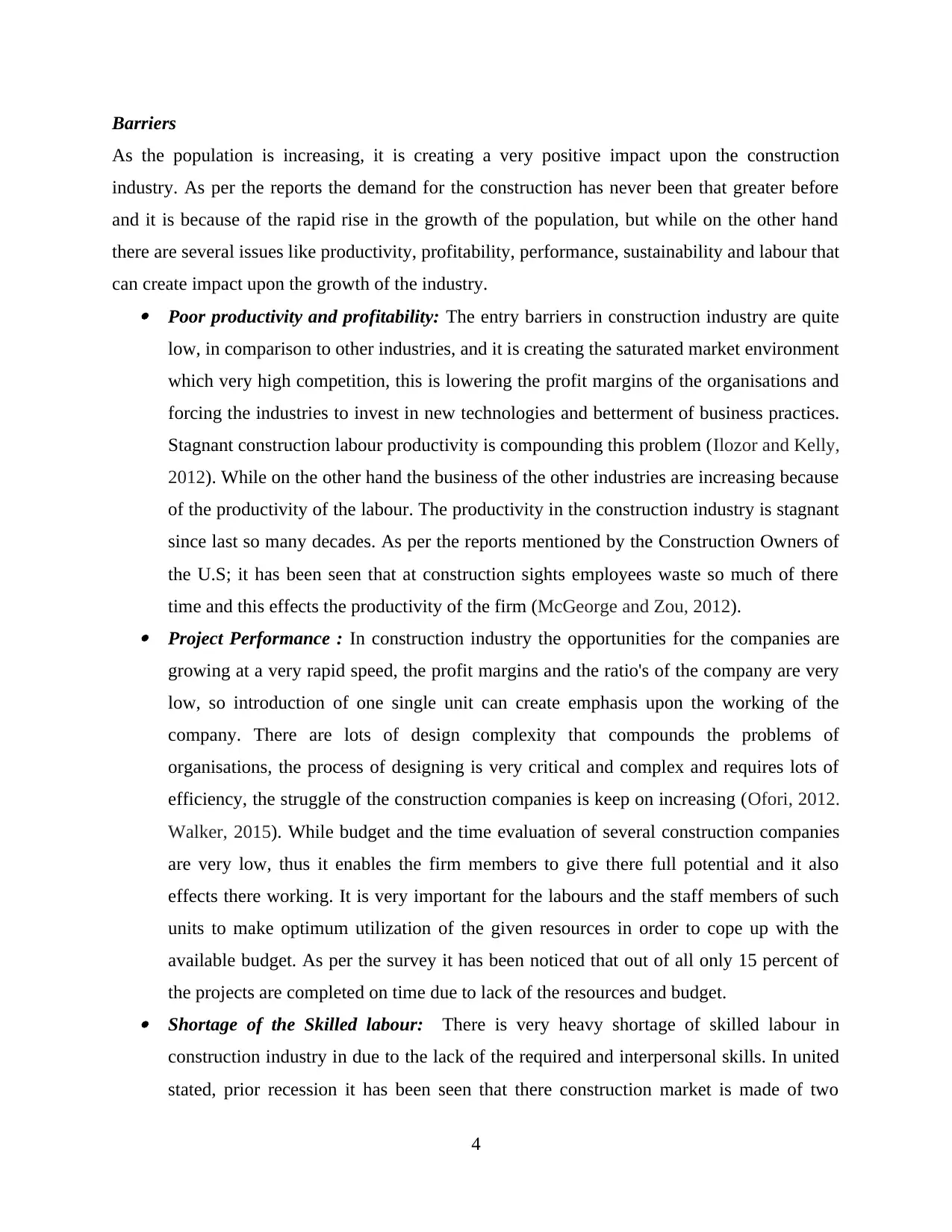
Barriers
As the population is increasing, it is creating a very positive impact upon the construction
industry. As per the reports the demand for the construction has never been that greater before
and it is because of the rapid rise in the growth of the population, but while on the other hand
there are several issues like productivity, profitability, performance, sustainability and labour that
can create impact upon the growth of the industry. Poor productivity and profitability: The entry barriers in construction industry are quite
low, in comparison to other industries, and it is creating the saturated market environment
which very high competition, this is lowering the profit margins of the organisations and
forcing the industries to invest in new technologies and betterment of business practices.
Stagnant construction labour productivity is compounding this problem (Ilozor and Kelly,
2012). While on the other hand the business of the other industries are increasing because
of the productivity of the labour. The productivity in the construction industry is stagnant
since last so many decades. As per the reports mentioned by the Construction Owners of
the U.S; it has been seen that at construction sights employees waste so much of there
time and this effects the productivity of the firm (McGeorge and Zou, 2012). Project Performance : In construction industry the opportunities for the companies are
growing at a very rapid speed, the profit margins and the ratio's of the company are very
low, so introduction of one single unit can create emphasis upon the working of the
company. There are lots of design complexity that compounds the problems of
organisations, the process of designing is very critical and complex and requires lots of
efficiency, the struggle of the construction companies is keep on increasing (Ofori, 2012.
Walker, 2015). While budget and the time evaluation of several construction companies
are very low, thus it enables the firm members to give there full potential and it also
effects there working. It is very important for the labours and the staff members of such
units to make optimum utilization of the given resources in order to cope up with the
available budget. As per the survey it has been noticed that out of all only 15 percent of
the projects are completed on time due to lack of the resources and budget. Shortage of the Skilled labour: There is very heavy shortage of skilled labour in
construction industry in due to the lack of the required and interpersonal skills. In united
stated, prior recession it has been seen that there construction market is made of two
4
As the population is increasing, it is creating a very positive impact upon the construction
industry. As per the reports the demand for the construction has never been that greater before
and it is because of the rapid rise in the growth of the population, but while on the other hand
there are several issues like productivity, profitability, performance, sustainability and labour that
can create impact upon the growth of the industry. Poor productivity and profitability: The entry barriers in construction industry are quite
low, in comparison to other industries, and it is creating the saturated market environment
which very high competition, this is lowering the profit margins of the organisations and
forcing the industries to invest in new technologies and betterment of business practices.
Stagnant construction labour productivity is compounding this problem (Ilozor and Kelly,
2012). While on the other hand the business of the other industries are increasing because
of the productivity of the labour. The productivity in the construction industry is stagnant
since last so many decades. As per the reports mentioned by the Construction Owners of
the U.S; it has been seen that at construction sights employees waste so much of there
time and this effects the productivity of the firm (McGeorge and Zou, 2012). Project Performance : In construction industry the opportunities for the companies are
growing at a very rapid speed, the profit margins and the ratio's of the company are very
low, so introduction of one single unit can create emphasis upon the working of the
company. There are lots of design complexity that compounds the problems of
organisations, the process of designing is very critical and complex and requires lots of
efficiency, the struggle of the construction companies is keep on increasing (Ofori, 2012.
Walker, 2015). While budget and the time evaluation of several construction companies
are very low, thus it enables the firm members to give there full potential and it also
effects there working. It is very important for the labours and the staff members of such
units to make optimum utilization of the given resources in order to cope up with the
available budget. As per the survey it has been noticed that out of all only 15 percent of
the projects are completed on time due to lack of the resources and budget. Shortage of the Skilled labour: There is very heavy shortage of skilled labour in
construction industry in due to the lack of the required and interpersonal skills. In united
stated, prior recession it has been seen that there construction market is made of two
4
⊘ This is a preview!⊘
Do you want full access?
Subscribe today to unlock all pages.

Trusted by 1+ million students worldwide
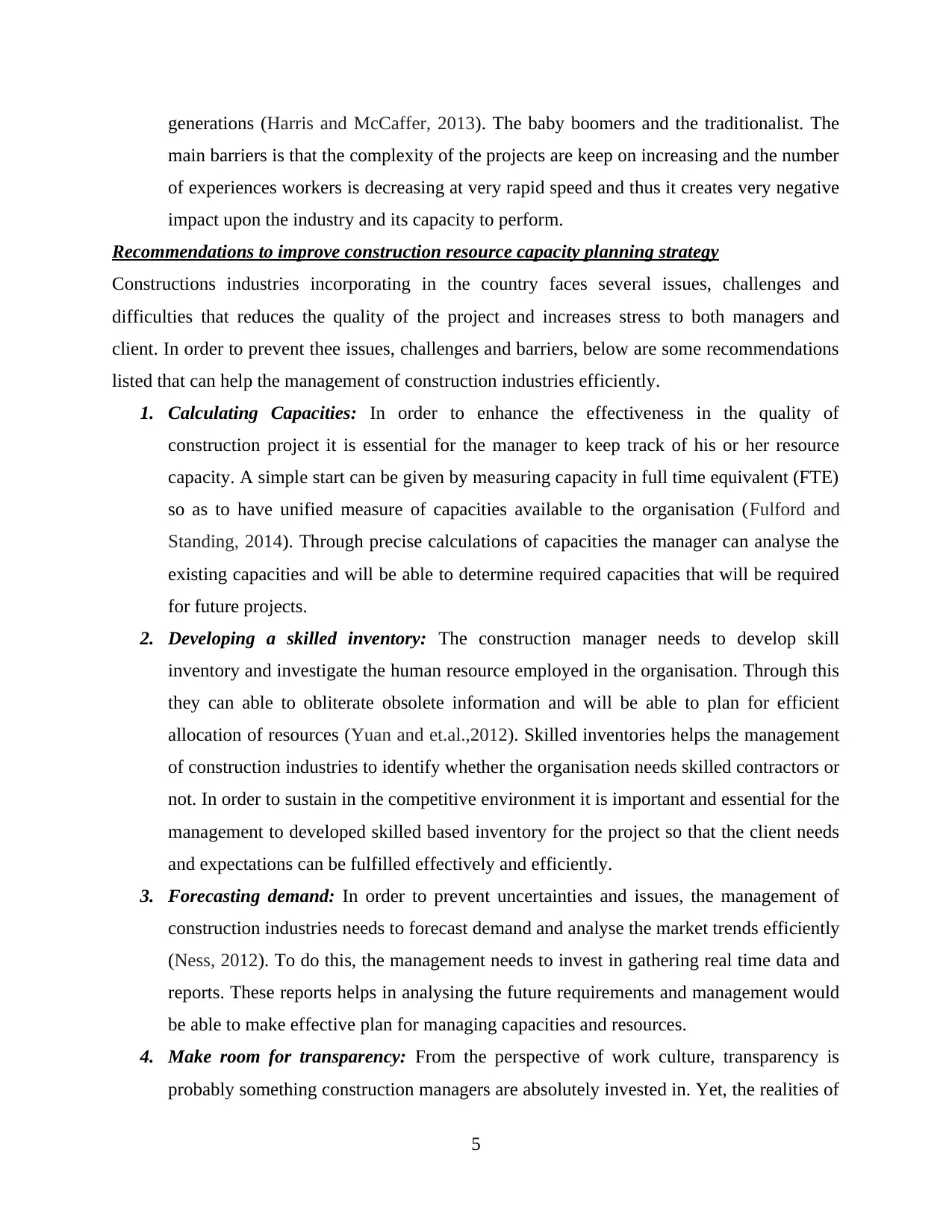
generations (Harris and McCaffer, 2013). The baby boomers and the traditionalist. The
main barriers is that the complexity of the projects are keep on increasing and the number
of experiences workers is decreasing at very rapid speed and thus it creates very negative
impact upon the industry and its capacity to perform.
Recommendations to improve construction resource capacity planning strategy
Constructions industries incorporating in the country faces several issues, challenges and
difficulties that reduces the quality of the project and increases stress to both managers and
client. In order to prevent thee issues, challenges and barriers, below are some recommendations
listed that can help the management of construction industries efficiently.
1. Calculating Capacities: In order to enhance the effectiveness in the quality of
construction project it is essential for the manager to keep track of his or her resource
capacity. A simple start can be given by measuring capacity in full time equivalent (FTE)
so as to have unified measure of capacities available to the organisation (Fulford and
Standing, 2014). Through precise calculations of capacities the manager can analyse the
existing capacities and will be able to determine required capacities that will be required
for future projects.
2. Developing a skilled inventory: The construction manager needs to develop skill
inventory and investigate the human resource employed in the organisation. Through this
they can able to obliterate obsolete information and will be able to plan for efficient
allocation of resources (Yuan and et.al.,2012). Skilled inventories helps the management
of construction industries to identify whether the organisation needs skilled contractors or
not. In order to sustain in the competitive environment it is important and essential for the
management to developed skilled based inventory for the project so that the client needs
and expectations can be fulfilled effectively and efficiently.
3. Forecasting demand: In order to prevent uncertainties and issues, the management of
construction industries needs to forecast demand and analyse the market trends efficiently
(Ness, 2012). To do this, the management needs to invest in gathering real time data and
reports. These reports helps in analysing the future requirements and management would
be able to make effective plan for managing capacities and resources.
4. Make room for transparency: From the perspective of work culture, transparency is
probably something construction managers are absolutely invested in. Yet, the realities of
5
main barriers is that the complexity of the projects are keep on increasing and the number
of experiences workers is decreasing at very rapid speed and thus it creates very negative
impact upon the industry and its capacity to perform.
Recommendations to improve construction resource capacity planning strategy
Constructions industries incorporating in the country faces several issues, challenges and
difficulties that reduces the quality of the project and increases stress to both managers and
client. In order to prevent thee issues, challenges and barriers, below are some recommendations
listed that can help the management of construction industries efficiently.
1. Calculating Capacities: In order to enhance the effectiveness in the quality of
construction project it is essential for the manager to keep track of his or her resource
capacity. A simple start can be given by measuring capacity in full time equivalent (FTE)
so as to have unified measure of capacities available to the organisation (Fulford and
Standing, 2014). Through precise calculations of capacities the manager can analyse the
existing capacities and will be able to determine required capacities that will be required
for future projects.
2. Developing a skilled inventory: The construction manager needs to develop skill
inventory and investigate the human resource employed in the organisation. Through this
they can able to obliterate obsolete information and will be able to plan for efficient
allocation of resources (Yuan and et.al.,2012). Skilled inventories helps the management
of construction industries to identify whether the organisation needs skilled contractors or
not. In order to sustain in the competitive environment it is important and essential for the
management to developed skilled based inventory for the project so that the client needs
and expectations can be fulfilled effectively and efficiently.
3. Forecasting demand: In order to prevent uncertainties and issues, the management of
construction industries needs to forecast demand and analyse the market trends efficiently
(Ness, 2012). To do this, the management needs to invest in gathering real time data and
reports. These reports helps in analysing the future requirements and management would
be able to make effective plan for managing capacities and resources.
4. Make room for transparency: From the perspective of work culture, transparency is
probably something construction managers are absolutely invested in. Yet, the realities of
5
Paraphrase This Document
Need a fresh take? Get an instant paraphrase of this document with our AI Paraphraser
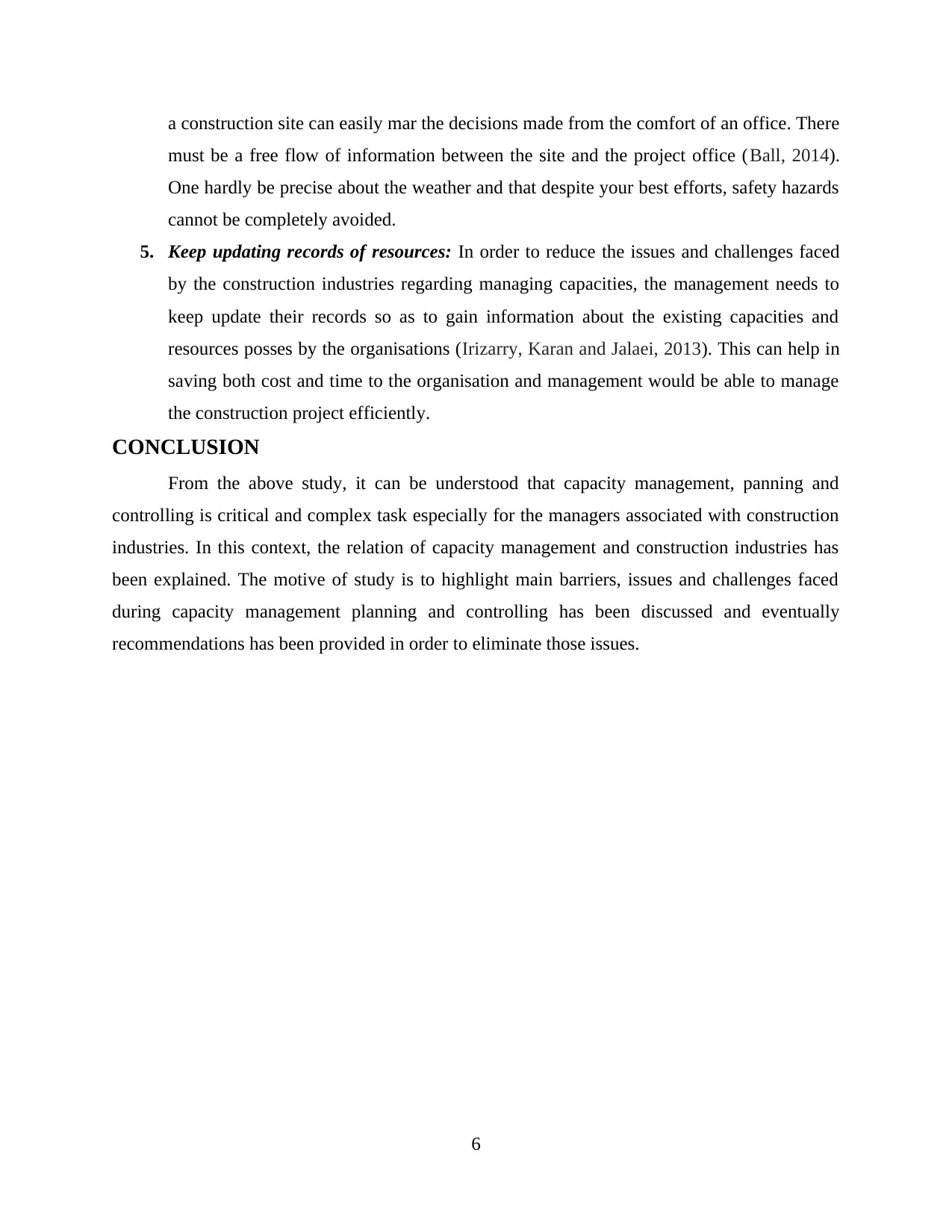
a construction site can easily mar the decisions made from the comfort of an office. There
must be a free flow of information between the site and the project office (Ball, 2014).
One hardly be precise about the weather and that despite your best efforts, safety hazards
cannot be completely avoided.
5. Keep updating records of resources: In order to reduce the issues and challenges faced
by the construction industries regarding managing capacities, the management needs to
keep update their records so as to gain information about the existing capacities and
resources posses by the organisations (Irizarry, Karan and Jalaei, 2013). This can help in
saving both cost and time to the organisation and management would be able to manage
the construction project efficiently.
CONCLUSION
From the above study, it can be understood that capacity management, panning and
controlling is critical and complex task especially for the managers associated with construction
industries. In this context, the relation of capacity management and construction industries has
been explained. The motive of study is to highlight main barriers, issues and challenges faced
during capacity management planning and controlling has been discussed and eventually
recommendations has been provided in order to eliminate those issues.
6
must be a free flow of information between the site and the project office (Ball, 2014).
One hardly be precise about the weather and that despite your best efforts, safety hazards
cannot be completely avoided.
5. Keep updating records of resources: In order to reduce the issues and challenges faced
by the construction industries regarding managing capacities, the management needs to
keep update their records so as to gain information about the existing capacities and
resources posses by the organisations (Irizarry, Karan and Jalaei, 2013). This can help in
saving both cost and time to the organisation and management would be able to manage
the construction project efficiently.
CONCLUSION
From the above study, it can be understood that capacity management, panning and
controlling is critical and complex task especially for the managers associated with construction
industries. In this context, the relation of capacity management and construction industries has
been explained. The motive of study is to highlight main barriers, issues and challenges faced
during capacity management planning and controlling has been discussed and eventually
recommendations has been provided in order to eliminate those issues.
6
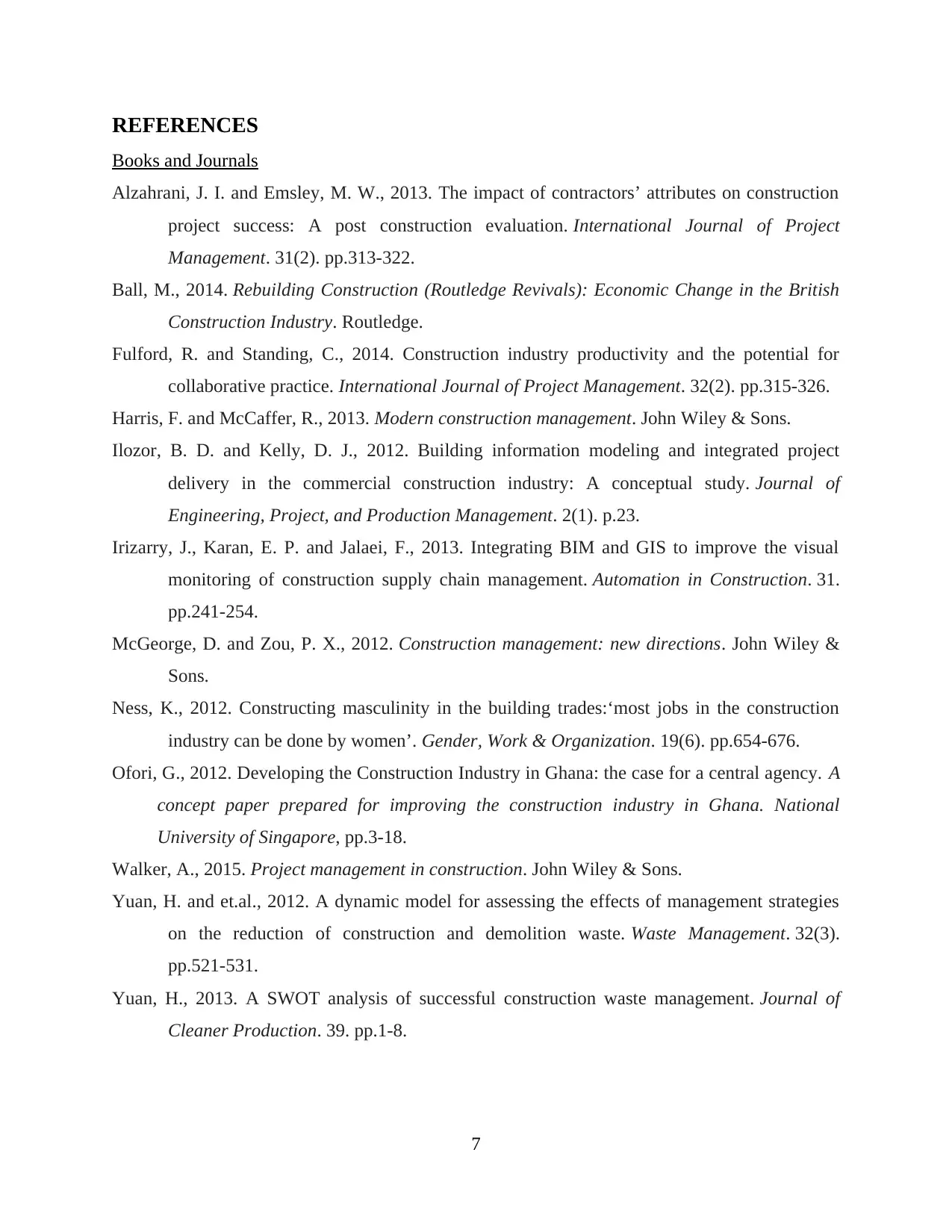
REFERENCES
Books and Journals
Alzahrani, J. I. and Emsley, M. W., 2013. The impact of contractors’ attributes on construction
project success: A post construction evaluation. International Journal of Project
Management. 31(2). pp.313-322.
Ball, M., 2014. Rebuilding Construction (Routledge Revivals): Economic Change in the British
Construction Industry. Routledge.
Fulford, R. and Standing, C., 2014. Construction industry productivity and the potential for
collaborative practice. International Journal of Project Management. 32(2). pp.315-326.
Harris, F. and McCaffer, R., 2013. Modern construction management. John Wiley & Sons.
Ilozor, B. D. and Kelly, D. J., 2012. Building information modeling and integrated project
delivery in the commercial construction industry: A conceptual study. Journal of
Engineering, Project, and Production Management. 2(1). p.23.
Irizarry, J., Karan, E. P. and Jalaei, F., 2013. Integrating BIM and GIS to improve the visual
monitoring of construction supply chain management. Automation in Construction. 31.
pp.241-254.
McGeorge, D. and Zou, P. X., 2012. Construction management: new directions. John Wiley &
Sons.
Ness, K., 2012. Constructing masculinity in the building trades:‘most jobs in the construction
industry can be done by women’. Gender, Work & Organization. 19(6). pp.654-676.
Ofori, G., 2012. Developing the Construction Industry in Ghana: the case for a central agency. A
concept paper prepared for improving the construction industry in Ghana. National
University of Singapore, pp.3-18.
Walker, A., 2015. Project management in construction. John Wiley & Sons.
Yuan, H. and et.al., 2012. A dynamic model for assessing the effects of management strategies
on the reduction of construction and demolition waste. Waste Management. 32(3).
pp.521-531.
Yuan, H., 2013. A SWOT analysis of successful construction waste management. Journal of
Cleaner Production. 39. pp.1-8.
7
Books and Journals
Alzahrani, J. I. and Emsley, M. W., 2013. The impact of contractors’ attributes on construction
project success: A post construction evaluation. International Journal of Project
Management. 31(2). pp.313-322.
Ball, M., 2014. Rebuilding Construction (Routledge Revivals): Economic Change in the British
Construction Industry. Routledge.
Fulford, R. and Standing, C., 2014. Construction industry productivity and the potential for
collaborative practice. International Journal of Project Management. 32(2). pp.315-326.
Harris, F. and McCaffer, R., 2013. Modern construction management. John Wiley & Sons.
Ilozor, B. D. and Kelly, D. J., 2012. Building information modeling and integrated project
delivery in the commercial construction industry: A conceptual study. Journal of
Engineering, Project, and Production Management. 2(1). p.23.
Irizarry, J., Karan, E. P. and Jalaei, F., 2013. Integrating BIM and GIS to improve the visual
monitoring of construction supply chain management. Automation in Construction. 31.
pp.241-254.
McGeorge, D. and Zou, P. X., 2012. Construction management: new directions. John Wiley &
Sons.
Ness, K., 2012. Constructing masculinity in the building trades:‘most jobs in the construction
industry can be done by women’. Gender, Work & Organization. 19(6). pp.654-676.
Ofori, G., 2012. Developing the Construction Industry in Ghana: the case for a central agency. A
concept paper prepared for improving the construction industry in Ghana. National
University of Singapore, pp.3-18.
Walker, A., 2015. Project management in construction. John Wiley & Sons.
Yuan, H. and et.al., 2012. A dynamic model for assessing the effects of management strategies
on the reduction of construction and demolition waste. Waste Management. 32(3).
pp.521-531.
Yuan, H., 2013. A SWOT analysis of successful construction waste management. Journal of
Cleaner Production. 39. pp.1-8.
7
⊘ This is a preview!⊘
Do you want full access?
Subscribe today to unlock all pages.

Trusted by 1+ million students worldwide

8
1 out of 10
Related Documents
Your All-in-One AI-Powered Toolkit for Academic Success.
+13062052269
info@desklib.com
Available 24*7 on WhatsApp / Email
![[object Object]](/_next/static/media/star-bottom.7253800d.svg)
Unlock your academic potential
Copyright © 2020–2025 A2Z Services. All Rights Reserved. Developed and managed by ZUCOL.





